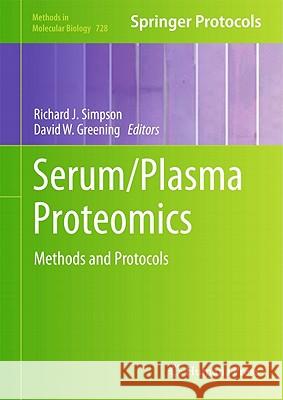Serum/Plasma Proteomics: Methods and Protocols » książka



Serum/Plasma Proteomics: Methods and Protocols
ISBN-13: 9781617790676 / Angielski / Twarda / 2011 / 412 str.
Serum/Plasma Proteomics: Methods and Protocols
ISBN-13: 9781617790676 / Angielski / Twarda / 2011 / 412 str.
(netto: 383,36 VAT: 5%)
Najniższa cena z 30 dni: 385,52
ok. 22 dni roboczych
Dostawa w 2026 r.
Darmowa dostawa!
Blood science has become a cornerstone of multiple disciplines. This book, contributed to by leading experts in the field, provides a comprehensive resource of protocols for areas, pre-analytical through to analytical, of plasma and serum proteomics.
Wydanie ilustrowane
Part I. Fractionation Strategies for In-depth Blood Proteome Analysis
1. Plasma Biomarker Discovery using 3-D Protein Profiling Coupled with Label-free Quantitation
Lynn A. Beer, Hsin-Yao Tang, Kurt T. Barnhart, and David W. Speicher
2. Intact Protein Separation by 1 and 2-dimension Liquid Chromatography for Comparative Proteomic Separation of Partitioned Serum or Plasma
Simon Sheng, Helena Skalnikova, Andrew Meng, Qin Fu, Allen Everett, and Jennifer E. Van Eyk
3. In-depth Analysis of a Plasma or Serum Proteome using a 4-D Protein Profiling Method
Hsin-Yao Tang, Huan Wang, Lynn A. Beer, and David W. Speicher
4. Intact-protein Analysis System (IPAS) for Discovery of Serum-based Disease Biomarkers
Hong Wang and Samir Hanash
5. Model-based Discovery of Circulating Biomarkers
Maryann S. Vogelsang and Parag Mallick
6. Low-molecular Weight Plasma Proteome Analysis using Centrifugal Ultrafiltration
David W. Greening and Richard J. Simpson
7. High-throughput Analysis of Glycoproteins from Plasma
Yan Li and Hui Zhang
Part II. Blood Collection and Handling Strategies
8. Minimizing Pre-analytical Variation of Plasma Samples by Proper Blood Collection and Handling
Jizu Yi, David Craft, and Craig A. Gelfand
9. Collection and Handling of Blood Specimens for Peptidomics
Harald Tammen and Rüdiger Hess
10. Investigation of Peptide Biomarker Stability in Plasma Samples using Time-course MS Analysis
Jizu Yi, Zhaoxia Liu, Craig A. Gelfand, and David Craft
Part III. Methods for Quantitative Assaying of Blood-Based Biomarkers
11. Biomarker Validation in Blood Specimens by Selected Reaction Monitoring Mass Spectrometry of N-glycosites
Reto Ossola, Ralph Schiess, Paola Picotti, Oliver Rinner, Lukas Reiter, and Ruedi Aebersold
12. A Fluorescent Microsphere-based Method for Assay of Multiple Analytes in Plasma Oliver K. Bernhard, Rommel A. Mathias, Thomas W. Barnes, and Richard J. Simpson
13. Immuno-mass Spectrometry: Quantification of Low Abundance Proteins in Biological Fluids
Vathany Kulasingam, Christopher R. Smith, Ihor Batruch, and Eleftherios P. Diamandis
14. Qualitative and Quantitative Analysis of Glycated Proteins in Human Plasma by Glucose Isotopic Labeling with 13C6-reducing Sugars
Feliciano Priego-Capote, Maria Ramírez-Boo, Denis Hochstrasser, and Jean-Charles Sanchez
Part IV. Proteome Analysis of Blood Cell Components, Vesicles, and Blood-related Fluids
15. Exosome Isolation for Proteomic Analyses and RNA Profiling
Douglas D. Taylor, Wolfgang Zacharias, and Cicek Gercel-Taylor
16. Extraction and Proteome Analysis of Liver Tissue Interstitial Fluid
Wei Sun, Ying Jiang, and Fuchu He
17. A Protocol for the Preparation of Cryoprecipitate and Cryo-depleted Plasma
Rosemary L. Sparrow, David W. Greening, and Richard J. Simpson
18. Preparation of Platelet Concentrates
David W. Greening, Richard J. Simpson, and Rosemary L. Sparrow
19. Phosphoproteome Analysis of the Platelet Plasma Membrane
Thomas Premsler, Urs Lewandrowski, Albert Sickmann, and René Peiman Zahedi
Part V. Bioinformatic Analysis of Blood Proteins and Peptides
20. Statistical Design and Analysis of Label-free LC-MS Proteomic Experiments: A Case Study of Coronary Artery Disease
Timothy Clough, Siegmund Braun, Vladimir Fokin, Ilka Ott, Susanne Ragg, Gunther Schadow, and Olga Vitek
21. Data Management in Mass Spectrometry-based Proteomics
Lennart Martens
22. Bioinformatics Challenges in the Proteomic Analysis of Human Plasma
Joseph M. Foster and Lennart Martens
23. Using the Human Plasma PeptideAtlas to Study Human Plasma Proteins
Terry Farrah, Eric W. Deutsch, and Ruedi Aebersold
Appendix I Standard operating procedures for plasma collection in clinical research
Tuck et al., (2009). J Proteome Res 8, 113-7
Appendix II Standard operating procedures for serum collection in clinical research
Tuck et al., (2009). J Proteome Res 8, 113-7
Appendix III Measured concentrations of plasma proteins from quantitative assays
Haab et al., (2005). Proteomics 5, 3278-91
Appendix IV Plasma proteome reference source
Appendix V Reference ranges for blood tests
Häggström (2010). Uppsala University Hospital ("Laborationslista"). Artnr 40284 Sj74a. Issued on April 22, 2008.
Blood science has become a cornerstone of multiple disciplines, including clinical chemistry, disease diagnosis, and therapeutic monitoring. Over the past decade, we have witnessed the advent of increasingly powerful proteomics technologies that allow greater fundamental insights into the blood proteome. These technological improvements have, in part, fuelled the quest for the discovery of novel blood-based biomarkers of disease. Serum/Plasma Proteomics: Methods and Protocols is a comprehensive resource of protocols for areas, pre-analytical through to analytical, of plasma and serum proteomics. Divided into five convenient sections, this detailed volume covers fractionation strategies for in-depth blood proteome analysis, defined procedures for blood collection, handling and storage, detailed protocols for performing both antibody-based and non-antibody based quantitative assays, proteome analysis of blood cell compartments, circulating nanomebraneous vesicles and blood-related fluids, and finally data management, statistical design, and bioinformatic challenges. This book, contributed to by leading experts in the field, provides a valuable foundation for the development and application of blood-based proteomics. Written in the highly successful Methods in Molecular Biology™ series format, chapters contain introductions to their respective topics, lists of the necessary materials and reagents, step-by-step, readily reproducible laboratory protocols, and notes on troubleshooting and avoiding known pitfalls.
Authoritative and easily accessible, Serum/Plasma Proteomics: Methods and Protocols, with its well-honed methodologies, seeks to serve both professionals and investigators new to the field in an effort to further our knowledge of this fundamental science.
1997-2025 DolnySlask.com Agencja Internetowa
KrainaKsiazek.PL - Księgarnia Internetowa









